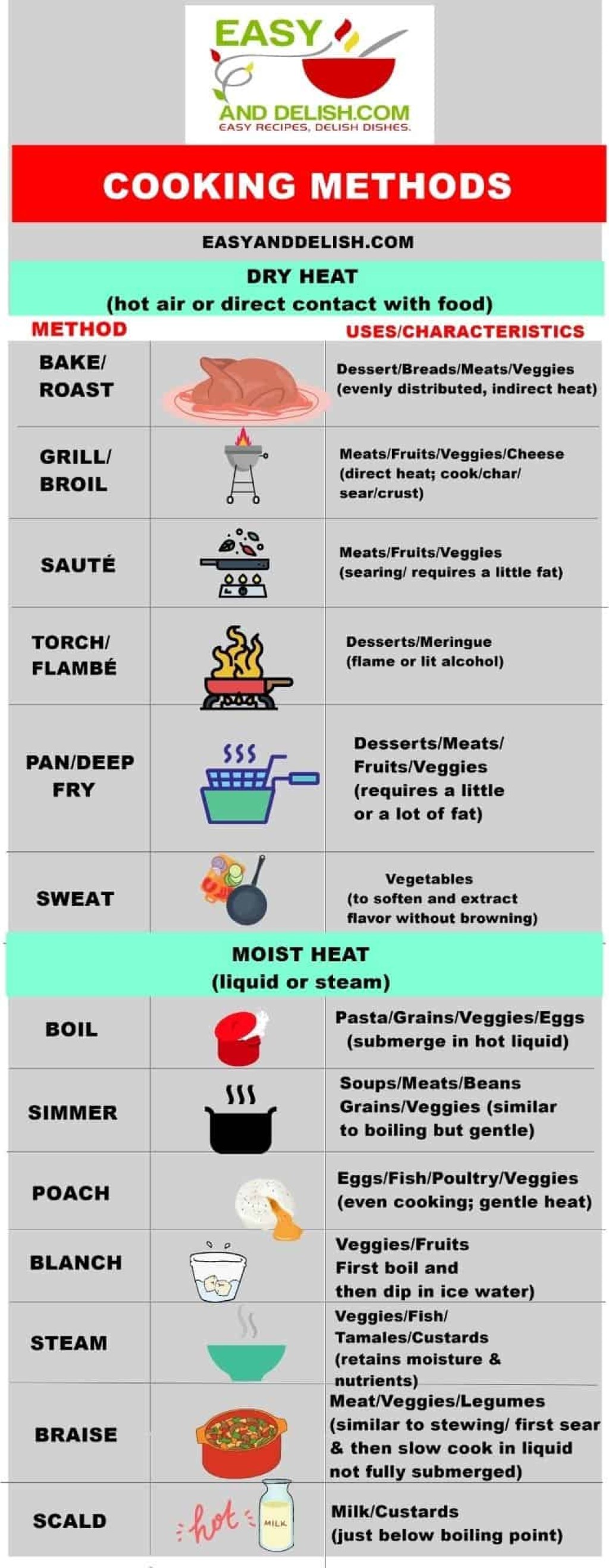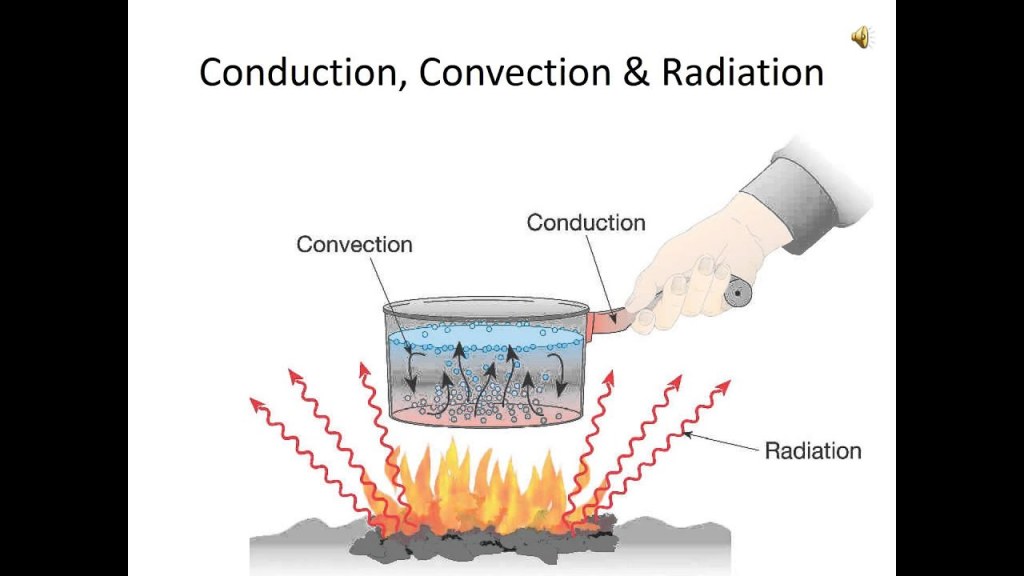Cooking Methods Heat Transfer: Understanding the Science Behind Culinary Techniques
Introduction
Dear Readers,
Welcome to this informative article on cooking methods and their relationship to heat transfer. Have you ever wondered why some cooking techniques produce different results? In this article, we will dive into the fascinating world of culinary science and explore the various ways heat is transferred during the cooking process. By understanding these principles, you will be able to elevate your cooking skills and create delicious meals with confidence. So, let’s embark on this culinary journey together!
What is Cooking Methods Heat Transfer?

Image Source: easyanddelish.com
🔥 Cooking methods heat transfer refers to the way heat is transferred from a heat source to food during the cooking process. It plays a crucial role in determining the outcome of your culinary creations. Understanding the different types of heat transfer methods will help you choose the right technique for each recipe and achieve the desired results.
There are three primary methods of heat transfer in cooking: conduction, convection, and radiation. Let’s explore each of them in detail.
Conduction
Conduction is the transfer of heat through direct contact between two objects. In cooking, this method is commonly used when food comes into contact with a hot surface, such as a frying pan or a grill. The heat is then transferred from the surface to the food, cooking it evenly. This method is ideal for searing meats and creating a crispy exterior.

Image Source: ytimg.com
🔥 Did you know? Cast iron pans are excellent conductors of heat, making them popular among professional chefs for their ability to distribute heat evenly.
Convection
Convection involves the transfer of heat through the movement of liquid or gas. In cooking, this method is achieved through the circulation of hot air or water. When using convection heat transfer, the food is exposed to a consistent flow of hot air or water, ensuring even cooking throughout. This method is commonly used in baking, roasting, and boiling.
🔥 Fun fact: Many modern ovens are equipped with convection settings, which use built-in fans to circulate hot air, reducing cooking time and producing more evenly cooked dishes.
Radiation
Radiation is the transfer of heat through electromagnetic waves. In cooking, this method occurs when food is exposed to direct heat, such as grilling or broiling. The heat energy is transferred through infrared radiation, quickly cooking the outer layer of the food while leaving the inside moist and flavorful. This method is perfect for achieving that smoky char on grilled meats and vegetables.
🔥 Did you know? Infrared grills use radiant heat, allowing for faster and more efficient cooking compared to traditional grills.
Who Uses Cooking Methods Heat Transfer?
👩🍳 Cooking methods heat transfer is essential knowledge for professional chefs, culinary students, and home cooks alike. Whether you are an aspiring chef, a passionate food enthusiast, or simply someone who enjoys cooking at home, understanding the principles of heat transfer will empower you to experiment with different techniques and create delicious meals.
When to Use Cooking Methods Heat Transfer?
📅 Cooking methods heat transfer comes into play every time you step into the kitchen. From searing a steak to baking a cake, each recipe requires a specific heat transfer method to achieve optimal results. By knowing when to use each method, you can elevate your cooking skills and ensure consistently delicious meals.
Where Can Cooking Methods Heat Transfer Be Applied?
🌍 Cooking methods heat transfer is a universal concept that can be applied in kitchens all around the world. Regardless of your location or cultural background, the principles of heat transfer remain the same. By understanding these principles, you can adapt any recipe to suit your culinary preferences and create dishes that delight your taste buds.
Why Is Cooking Methods Heat Transfer Important?
🔑 Understanding cooking methods heat transfer is crucial for several reasons. Firstly, it allows you to control the cooking process and achieve desired results consistently. By choosing the right heat transfer method, you can ensure that your food is cooked evenly, preventing undercooking or overcooking.
Secondly, knowing how heat is transferred during different cooking methods helps you make informed decisions about cookware and equipment. Certain materials conduct heat better than others, and being aware of these properties can aid in selecting the right tools for your culinary endeavors.
Lastly, mastering cooking methods heat transfer allows you to unleash your creativity in the kitchen. Armed with this knowledge, you can experiment with various techniques, adapt recipes, and create unique flavor profiles. The possibilities are endless!
How Does Cooking Methods Heat Transfer Work?
🔬 Cooking methods heat transfer works by utilizing the principles of conduction, convection, and radiation to transfer heat from a heat source to the food. Let’s take a closer look at how each method works:
Conduction:
In conduction, heat is transferred through direct contact between the heat source and the food. When a pan is placed on a stovetop burner, for example, the heat from the burner is conducted through the pan and into the food, cooking it evenly. The rate of conduction depends on the material of the pan and the heat source’s temperature.
Convection:
Convection involves the movement of heat through a liquid or gas medium. In the context of cooking, this typically refers to the circulation of hot air or water. In an oven, for instance, the hot air circulates around the food, transferring heat and ensuring even cooking. Convection can also occur when boiling water, as the hot water rises, displaces colder water, and creates a continuous flow of heat.
Radiation:
Radiation is the transfer of heat through electromagnetic waves. In cooking, this occurs when food is exposed to direct heat, such as grilling or broiling. The heat energy is transferred through infrared radiation, quickly cooking the outer layer of the food while leaving the inside moist and flavorful.
Advantages and Disadvantages of Cooking Methods Heat Transfer
Advantages:
1. Precise control over cooking results: By understanding cooking methods heat transfer, you can precisely control the cooking process and achieve consistent results.
2. Enhanced flavors and textures: Different heat transfer methods can create unique flavors and textures in your dishes, allowing you to experiment and create memorable culinary experiences.
3. Time efficiency: Utilizing the appropriate heat transfer method can significantly reduce cooking time, allowing you to prepare meals more efficiently.
4. Versatility: Cooking methods heat transfer can be applied to various ingredients and cuisines, giving you the freedom to explore different flavors and cooking styles.
5. Healthier cooking: By understanding heat transfer methods, you can cook food more evenly, preserving its nutritional value and minimizing the risk of undercooked or overcooked meals.
Disadvantages:
1. Equipment limitations: Certain heat transfer methods may require specialized equipment, limiting their accessibility to some home cooks.
2. Learning curve: Mastering different heat transfer methods may take time and practice, especially for beginners in the kitchen.
3. Energy consumption: Some heat transfer methods, such as radiation, can consume more energy compared to others, leading to higher utility bills.
4. Risk of burns or accidents: Working with high heat sources carries the risk of burns or accidents if proper safety precautions are not taken.
5. Complexity: Understanding the science behind heat transfer methods can be complex, requiring a basic understanding of physics and chemistry.
Frequently Asked Questions (FAQs)
Q: Can I use different heat transfer methods in the same recipe?
A: Absolutely! Many recipes incorporate multiple heat transfer methods to achieve the desired results. For example, you can sear a steak using conduction and then finish cooking it in the oven using convection.
Q: Which heat transfer method is the healthiest?
A: Each heat transfer method has its advantages and considerations. However, using methods that cook food evenly, such as convection, can help preserve the nutritional value of the ingredients.
Q: How can I prevent food from sticking to the pan during conduction cooking?
A: To prevent food from sticking, ensure that the pan is heated adequately before adding the ingredients. You can also use a thin layer of cooking oil or butter to create a non-stick surface.
Q: Are there any heat transfer methods specific to certain cuisines?
A: Yes, various cuisines utilize unique cooking techniques that rely on specific heat transfer methods. For example, tandoori cooking in Indian cuisine utilizes radiant heat transfer through a clay oven.
Q: Can I use convection heat transfer for baking bread?
A: Absolutely! Convection heat transfer is ideal for baking bread as it ensures even heat distribution, resulting in a crispy crust and a soft interior.
Conclusion: Elevate Your Culinary Skills with Cooking Methods Heat Transfer
In conclusion, understanding cooking methods heat transfer is essential for any aspiring cook or culinary enthusiast. By grasping the principles of conduction, convection, and radiation, you can confidently choose the right technique for each recipe, resulting in consistently delicious meals.
Remember, cooking is an art that combines science and creativity. By mastering the science of heat transfer, you can unlock endless possibilities in the kitchen and create delightful culinary masterpieces.
So, put on your chef’s hat, grab your favorite cookware, and embark on a culinary adventure where the magic of heat transfer awaits. Happy cooking!
Final Remarks
Dear Friends,
As we conclude this article on cooking methods heat transfer, we hope you have found it informative and inspiring. The world of culinary science is vast, and understanding the principles behind heat transfer is just the beginning of your culinary journey.
Remember, practice makes perfect, so don’t be afraid to experiment with different techniques and embrace the joy of cooking. Whether you’re a seasoned chef or a novice in the kitchen, always approach cooking with passion, curiosity, and a hunger for knowledge.
Disclaimer: The information provided in this article is for educational purposes only. Always follow proper safety guidelines and consult reliable sources for specific cooking instructions and advice.